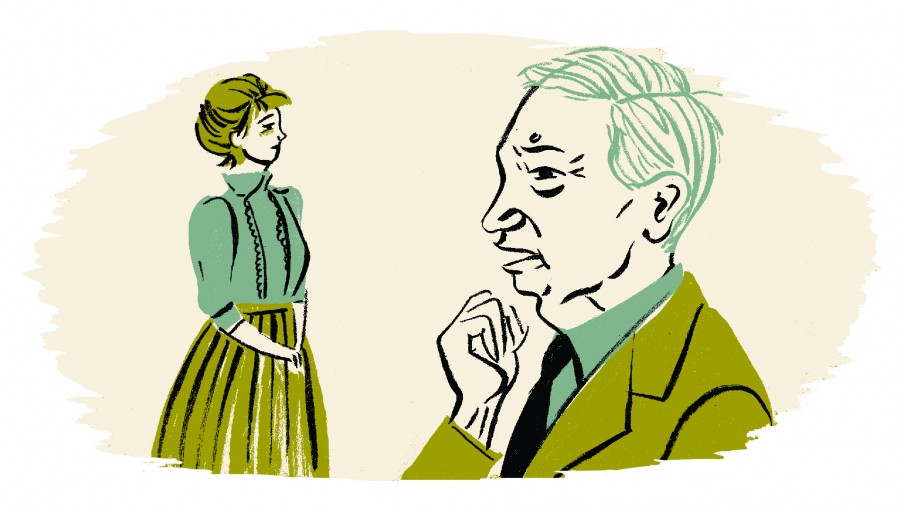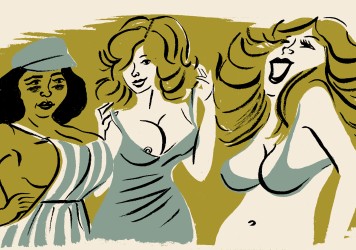
Words
Mark Asch, Forrest Cardamenis, Adam Cook, David Jenkins, Trevor Johnston, Sophie Monks Kaufman
Illustration
From John Schlesinger to Edward Yang, here’s the concluding part of our guide to the best last movies ever.
John Schlesinger will perhaps be remembered as the guy who brought gay/camp iconography to mainstream Hollywood in his Oscar-hauling Midnight Cowboy from 1969. So it seems strange that he would check-out with this tin eared, family-friendly take on modern metrosexual coupling. Madonna stars as a yoga instructor who can’t find Mr Right, even though she’s told on numerous occasions how pretty she is. Luckily, her gay best friend, played by Rupert Everett, is on hand to dress up, quaff Martinis and accidentally impregnate her.
What should’ve been a progressive film about sexuality and parenting – a decade before the beloved likes of Lisa Cholodenko’s The Kids Are All Right – turns into a mawkish and confused trawl through relationship woes in which the characters all come across as self-serving, petty imbeciles. Since his lightly radical formative years, Schlesinger made a pronounced move to more conventional fare during the final 25 years of his career, so this film which Robert Ebert evocatively described as being as “tired as a junkyard horse” simply stayed the course. David Jenkins
Over his career’s last decade, highbrow contrarian critics recast Tony Scott’s style as avant-garde. They said his image editing shattered point-of-view into a million little pieces. Déjà Vu, with its themes of trauma and voyeurism, gave Scott a chance to make his style seem personal and purposeful rather than glibly aggressive. But the supersaturated visual style and violent montage of Unstoppable revels in chaos as much as the film’s gleefully engineered smash-ups.
A film with an enormous carbon footprint, Unstoppable chases a runaway train through Pennsylvania, with news and rescue and second-unit helicopters along for the ride; its brand of populism is delightfully butch, as each character’s grace under pressure correlates with his body-fat percentage. How can I put this? Tony Scott films constantly defied the gravity of death and Unstoppable is the final chapter in that body of work. It’s the ultimate “escapism” – a definition given deeper shadings by Scott’s subsequent suicide. Mark Asch
Under Azure skies, African village life plays out: bartering with The Mercenaire, bringing water bowls to guests, female genital mutilation on girls so small and spindly that, topless, they could pass as boys. When four girls ask Collé for protection, she casts a spell of moolaadé that prevents the knife-wielding salindana from coming within slicing distance. Director Ousmane Sembène also used a spell to ward off sexist practice in his classic Xala from 1975, about a man unable to perform sexually. His oppressive characters hide behind tradition, which runs in stark contrast to the politically progressive filmmaker himself.
From his 1966 debut feature Black Girl until this his ninth and final film, Sembène was a free thinker, and he dignified the plight of those suppressed due to race, gender, disability or poverty. His values lurked beneath seemingly idyllic, colourful, detailed worlds that bustled with engrossing characters. Moolaadé is a fine swan song showcasing everything that he did best. His radical and subtle writing is packaged within seemingly throwaway episodes which all carry critiques so sharp that they still have to power to draw blood. Sophie Monks Kaufman
“Who wants to see the ugliness of life?” Hollywood producer Ross Hunter once said when reflecting on his career. “I gave the public what they wanted – a chance to dream, to live vicariously, to see beautiful women, jewels, gorgeous clothes, melodrama.” Hunter was a perfect foil for Douglas Sirk, who could deliver all of the elegance that his producer demanded but who also made films that subverted and critiqued such opulence, adding some grit to the glamour. Sirk’s last film was Imitation of Life, which is arguably his most damning indictment of American values, depicting a selfish and prejudiced society in which people are obsessed with surfaces.
While the film was conceived as a star vehicle for Lana Turner – seeking rehabilitation after the violent end to her relationship with Johnny Stompanato – the real drama exists in the relationship between two supporting characters, black maid Annie (Juanita Moore) and her light-skinned daughter Sarah Jane (Susan Kohner). Pursuing a life that is off-limits to her, Sarah Jane passes as white and rejects her own mother, making this one of the most poignant and incisive studies of race ever made by a major Hollywood studio.
Sirk was only in his early 60s when Imitation of Life was released but he had long decided that this would be his last film. Health concerns were a factor, but he also seemed aware that the era of the ‘women’s picture’ was coming to an end, and indeed the rise of soap operas on television soon spelled the end for features like this. Sirk knew his time was up, and judging by his subsequent output, Ross Hunter probably should have called it a day with this film too. Phil Concannon
Josef von Sternberg is known as something of an attention seeker, especially with regard to Marlene Dietrich. Dietrich’s star power is so great and Sternberg’s scene-building is so visually complex that his innovations with sound are often overlooked. For that reason, Anatahan, based on a true story of a Japanese platoon stranded on the eponymous volcanic island with a single woman for seven years during and after World War Two, is rarely mentioned among his most important works.
Sternberg shoots Akemi Negishi without the infatuation and worship with which he shot Dietrich, and his paper and aluminium sets take on a parodic tone as the ‘Queen Bee’ continues to cause the men, intentionally or not, to gradually pick one another off. Artifice and sounds, however, are key motifs, lost in the storm of the intentional but denigrated cookie-cutter images. The narration that speaks for and about the characters, forces a distance that the close-ups of Dietrich’s legs never allowed for. Several films and decades of doing one thing brilliantly bred expectations, but Sternberg deserves credit for inverting his style to recast his stance on male passion and a woman’s power. Forrest Cardamenis

Seijun Suzuki’s films are unintelligible on a plot and, indeed, a shot-by-shot level. Basic continuity is scrapped as figures pose against garish Pop backgrounds in sequences of modernist compositions seemingly cut to Ornette Coleman tracks. Against such anarchy, there can be no diffidence: all attitudes are obsessive, all desires elemental. Princess Raccoon is, then, the perfect Suzuki love story.
Adapted from a Japanese folk tale, the object of affection is a shape-shifting animal spirit. The film is a musical, made up of all-hands-on-deck song-and-dance numbers and intimate pas de deux – when not digressing into zany lowbrow comedy, or martial arts, which unfold across soundstage kabuki sets, natural exteriors and green-screen scenic paintings. Most unmistakably, it’s a passionate, exuberant work. Now 92, the director has made it clear that the film is his career’s celebratory exclamation point. MA
They called him “Wild Bill” Wellman for good reason. Expelled from his Massachusetts high school, he joined the French Foreign Legion during World War One and at 21 had signed up for the Lafayette Flying Corps, racking up three recorded kills over the skies of Alsace Lorraine before being shot down himself. He lived to tell the tale, made it to Hollywood and directed the first-ever Oscar-winner, 1927’s Wings, which still impresses for its hair-raising aerial combat sequences. After career highlights including the Jimmy Cagney gangster classic The Public Enemy and the original 1937 A Star is Born, he returned to World War One territory for what would be his last picture, 1958’s Lafayette Escadrille.
There’s a surge of genuine emotion early on when Wellman follows the fate of those youthful American idealists who died in droves for the French cause. But elsewhere the film’s stymied by its low-rent cast and penny-pinching budget, with only a smidgin of flying action and much turgid romance involving decorative yet wooden co-stars Tab Hunter and Etchika Choreau. Not the greatest send-off then, yet the sincerity of Wellman offering tribute to the sacrifices of his own great generation clearly stands for something. Trevor Johnston
There is a rare type of film that, when you watch it, you can actually sense that it’s some sort of parting gesture. During its three-hour running time, Edward Yang’s humanistic masterpiece Yi Yi (or, as it was known in the UK, A One And A Two…) feels like the distillation of generations of accrued wisdom, a poetic collection of observations on the struggles and beauty of life in urban Taipei. With its multi-character ensemble and an enquiring point-of-view that feels like a distinct presence watching over the actions, the film is anchored by the malaise-struck middle-class businessman, NJ, his teenage daughter Ting-Ting, and most movingly, by her kid brother Yang-Yang, as they all navigate tricky daily terrain at different stages of life.
Yang generously presents each character’s perspective on its own terms over the course of a single year, beginning with a wedding and ending with a funeral. Yang did not know this would be his final film – it was seven years later that he lost a battle with cancer at the age of 59. This huge loss for cinema is made a little easier to bear thanks to the existence of this film, which has the power to teach, console, inspire, and even engage with life anew with its compassionate yet measured take on the human experience. Adam Cook
Cinematic Swan Songs: A-F | G-L | M-R
Published 6 Feb 2016

An alphabetic index of the most marvellous and memorable final movies from famous directors.

From Yilmaz Güney to John Huston, read part two of our essential guide to the last films by famous directors.

From Joseph L Mankiewicz to Eric Rohmer, check out the penultimate batch from our rundown of memorable last movies.